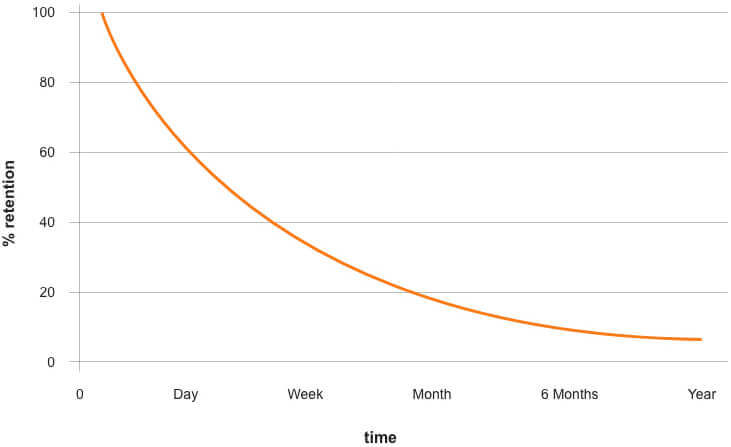It’s one of the most common problems that every company faces, regardless of industry or size— how do you help employees remember and apply the training they’ve received?
No matter how engaging or impactful your training is, people just can’t remember all of it as time goes by. This phenomenon is called the Ebbinghaus forgetting curve, named for the psychologist to first identify it.
Discover what it is, and most importantly, how you can help yourself and your teams fight it.
What is the forgetting curve?
The terms “Ebbinghaus forgetting curve definition’ and ‘forgetting curve psychology definition’ both refer to the rapid decline in memory retention over time. Identified by German psychologist Hermann Ebbinghaus in the 1880s, he found that within an hour of learning new information people tend to forget up to 50% of it. Within 24 hours, this can increase to 70%. By the end of the week, people tend to retain only about 25% of what they’ve learned. This rapid forgetting curve can have serious implications for individuals and businesses alike, which is why it is important to understand how it works and how to overcome it.
Ebbinghaus and the forgetting curve— why it matters
Ebbinghaus’s groundbreaking research on the forgetting curve remains relevant and important today, nearly 200 years after it was conducted. By studying memory retention, he was able to identify the factors that contribute to forgetting and to develop strategies for overcoming it. One of his key findings was that repetition and reinforcement are critical for retaining information over time.
Illustrating Ebbinghaus’s forgetting curve, studies have shown that, without reinforcement, people tend to forget up to 90% of what they’ve learned within a month. This underscores the importance of companies and training managers developing effective strategies for retention and reinforcement in order to ensure that learning and development efforts are not wasted.
Illustrating Ebbinghaus’s forgetting curve

Here you can see a visual representation of the forgetting curve, showing that the decline in memory is very steep in the first hours and days of learning something new, and then levels off as time goes on. A survey of 600 frontline workers conducted by TalentCards showed that people actually underestimate how much they forget, and that the forgetting curve is steeper than we realize.
When asked if they remembered at least 50% of their training 30 days after completing it, 69% said yes. 54% said they could remember more than half of their training even after 6 months of completing it. The reality is that by this point, the average person will remember less than 20% of what they learned if they haven’t taken the time to reinforce their knowledge.
Ebbinghaus forgetting curve examples
Here are four common examples where you’ve probably experienced the forgetting curve first hand:
- Cramming for an exam: If you cram for an exam the night before, you may remember the information well enough to pass the test the next day, but within a week, you are likely to have forgotten much of what you learned.
- Learning a new language: If you are not consistently practicing and using the new language you are trying to learn, you’ll find you won’t remember it the moment you need it, no matter how well you could speak in the past.
- Remembering names: If you meet someone and don’t make an effort to remember their name at that moment, you’ll probably have forgotten it within the hour.
- Memorizing phone numbers: You may remember memorizing phone numbers by “chunking” them into three digits, the next three digits, and then the final four. But in the age of smartphones, you simply tap the contact you want to call and those phone numbers you memorized in the past may no longer be in your memory.
Overcoming the forgetting curve
Helping employees overcome the forgetting curve in the context of their work can be a challenge. Employees may go through training, but without reinforcement, much of the information will be lost over time.
Fortunately, there are steps organizations can take to combat the forgetting curve and to understand how information processing theory plays a role in your training initiatives. Here are four tips to help employees overcome the forgetting curve:
Leverage the power of spaced learning
Spaced learning is a technique where information is reinforced at regular intervals to help with retention. In practice, this means that training should be reinforced on a regular basis to ensure that the information is remembered. Rather than simply providing training once and expecting employees to remember it forever, organizations should schedule regular refresher training and follow-up sessions to reinforce key concepts.
Create microlearning versions of long courses
Employees may not have the time or patience to review long courses on a regular basis. To make it easier for them to review key concepts, you can create microlearning versions of long courses. These shorter versions cover the most important points and are much easier and quicker for employees to review. By breaking down training into bite-sized chunks, employees are more likely to review it regularly.
Ensure training material is easy to access
If training material is a pain to locate and access, employees are less likely to review it. To combat this issue, you should try to ensure that training material is mobile accessible. By providing easy access to training materials on employees’ mobile devices, you can make it more convenient for employees to review the material during their free time, and therefore more likely that they will.
Reward employees who regularly review training
Employees who take the time to review training material regularly are more likely to retain key information. To encourage this positive behavior, have a training platform in place that allows managers to see who is logging in and spending time reviewing their material, and passing assessments. By recognizing and rewarding employees who regularly review training, you’ll reinforce the importance of ongoing learning and development among your team.
Help employees fight the forgetting curve with a powerful microlearning app

FAQs
What did Ebbinghaus say about forgetting?
Ebbinghaus’ showed that we forget information at a rapid rate soon after learning it, with the majority of forgetting occurring within the first few days. He also found that forgetting continues at a slower rate over time. These insights led to the development of the forgetting curve, which is a graphical representation of how we forget information over time.
What did Ebbinghaus discover about the learning curve?
While Ebbinghaus discovered that the majority of forgetting happens in the first few days after learning something new, it can be combated by using strategies such as spaced learning and active recall, to help flatten the learning curve.
How do you use the Ebbinghaus forgetting curve?
The Ebbinghaus forgetting curve can be used as a guide to improve learning and memory retention. You can fight the forgetting curve with these strategies:
- Space out learning sessions
- Use active recall
- Repeat the information
- Use mnemonic devices
- Practice regularly
What were Ebbinghaus’s key findings?
- The forgetting curve: Ebbinghaus discovered that forgetting occurs at a rapid rate soon after learning, with the majority of forgetting occurring within the first few days. However, after this initial drop in the recall, forgetting continues at a slower rate over time.
- Spacing effect: Ebbinghaus found that spacing out learning sessions over time improves memory retention compared to massed practice (cramming).
- Overlearning: Ebbinghaus discovered that overlearning (repeated practice beyond mastery) could help improve the long-term retention of information.
- Serial position effect: Ebbinghaus found that the position of information in a list (primacy or recency) affects how well it is remembered.
- Forgetting is affected by interference: Ebbinghaus found that forgetting is influenced by interference or the presence of other information that competes for attention.
Don’t forget about the forgetting curve
By recognizing the rapid rate at which we forget information soon after learning it, we can take steps to improve our memory retention and combat the effects of the forgetting curve. With strategies like spaced learning, active recall, repetition, mnemonic devices, and regular practice, you can prove employees’ ability to retain information over the long term.
Key takeaways
- Employees tend to forget new information at a rapid rate, with much of the forgetting occurring in the first few hours and days after learning.
- To combat the forgetting curve, managers should encourage spaced learning and repetition of training material.
- Creating microlearning versions of long courses can make it easier for employees to review and retain important information.
- Making training materials mobile accessible can help employees review information on the go and reinforce learning.
- Rewarding employees who regularly review training material can help incentivize continuous learning and combat the effects of the forgetting curve


